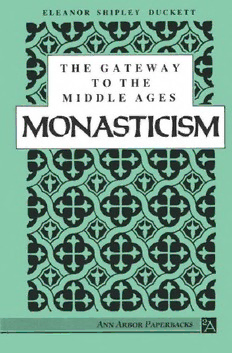
The Gateway to the Middle Ages: Monasticism PDF
Preview The Gateway to the Middle Ages: Monasticism
T H E G A T E W A Y TO T H E M I D D L E A G E S M O N A S T I C I S M The Gateway to the Middle Ages MONASTICISM by Eleanor Shipley Duckett ANN ARBOR PAPERBACKS THE UNIVERSITY OF MICHIGAN PRESS FIRST EDITION AS AN ANN ARBOR PAPERBACK 1961 REISSUED AS AN ANN ARBOR PAPERBACK 1988 COPYRIGHT © BY THE UNIVERSITY OF MICHIGAN 1938, RENEWED 1966 ALL RIGHTS RESERVED ISBN 0-472-09051-8 (doth) ISBN 0-472-06051-1 (paper) LIBRARY OF CONGRESS CARD CATALOG NO. 61-2247 PUBLISHED IN THE UNITED STATES OF AMERICA BY THE UNIVERSITY OF MICHIGAN PRESS MANUFACTURED IN THE UNITED STATES OF AMERICA 1991 1990 1989 1988 4 3 2 TO M ary Ellen C hase and O ur Cambridge Family CAMBRIDGE, ENGLAND i934-1936 ABBREVIATIONS P L ....................... Patrologia Latina P G ....................... Patrologia Graeca M.G.H..................... Monumenta Germaniae Historica M.H.B..................... Monumenta Historica Britannica R.I.S......................... Rerum Italicarum Scriptores (Muratori) Script, rer. Merov. Scriptores Rerum M er ovin gic arum Script, rer. Lang. . Scriptores Rerum Langobardicarum C.S.H.B. . . . Corpus Scriptorum Historiae Byzantinae C.S.E.L.................... Corpus Scriptorum Ecclesiasticorum Latinorum P.L.M...................... Poetae Latini Minores P.W.......................... Real-Encyclopadie, ed. Pauly-Wissowa C.M.H..................... Cambridge Medieval History H.S.C.P................... Harvard Studies in Classical Philology C.P........................... Classical Philology Schanz . . . . Schanz-Hosius-Kriiger : Geschichte der rômischen Literatur, IV, 2, 1920 Manitius . . . M. Manitius : Geschichte der lateinischen Literatur des Mittelalters, I, 1911 Bardenhezver . . O. Bardenhewer: Geschichte der alt- kirchlichen Literatur, V, 1932 PREFAJCE T he gateway to the middle ages is made up of three parts. This one deals with monasticism in the sixth century. Monasticism at that time followed one of two disciplines, according to the race, country, and temperament of its fol lowers: Celtic or Roman. Celtic monks belonged to the British, in Wales and the southwest of Britain; to the Irish in Ireland and in Scot land; and to those of the British who in fear of Saxon enemies or through love of wandering had crossed the Channel to find their peace abroad. In Wales there was at this time the monastery of Abbot Illtyd at Llantwit Major; of David at Mynyw or Menevia, St. David’s in Pembrokeshire; of Cadoc at Llancarfan. From Wales monks journeyed in their frail wicker boats to Cornwall and thence to Brittany, where we meet, with many others, Samson at Dol and Paul Aurelian at Saint- Pol-de-Leon. For the Irish this sixth century was a Golden Age of monks and monasteries, established in their multitude up and down the land: by Finnian at Clonard in Meath; by another Finnian at Moville in County Down; by Comgall at Bangor on Belfast Lough; by Ciaran at Clonmacnois on the Shannon; by other founders without number. The rule followed by these Celtic monks was common only in its fundamentals, and these were hard; fasting and vigil, prayer and penance, filled the hours of the day and PREFACE many of the night. To holy observance was added zeal of scholarship; each of the greater Irish abbeys had its school, in which students of the Bible and the Latin fathers, of Christian doctrine and pagan Latin texts, listened to their teachers and pondered their few manuscripts whenever they could turn from fulfilling their round of prayer, from the carrying out of those manual tasks which gave them the bare necessities of life. Many men, also vowed to the same monastic ideal, were seeking it in the solitude so beloved by the Celtic spirit, on isles off Irish and British shores, on islets in lake and river, wherever their wandering had led them. It was the monks of Roman discipline, however, who prepared the way for the coming of the great monastic orders of the Middle Ages. Among these we find in our sixth century those of the congregation established by that Cassiodorus who had been minister to Theodoric the Great, in his own country house, “Vivarium,” “Fishpools,” amid the meadows of southern Italy. Here his leisure from politi cal labors has left us writings of high importance on his training of his monks in discipline both sacred and secular. From Italy we come to Arles in southern France, to find its bishop, Caesarius, drawing up his Rule for nuns, for women living the monastic life under his guidance. Caesarius had a gift of common sense as well as sanctity, and in his provisions we come upon much of interest in regard to these good sisters, some of humble, others of most aristocratic birth. Even more interesting, however, were the sermons in which with scathing rebuke he stripped bare during mass the hidden consciences of his guilty flock. And now we come to the climax: to the life of Saint Benedict of Nursia and to the Rule compiled by him for his monks of the sixth century in the abbey of Monte
